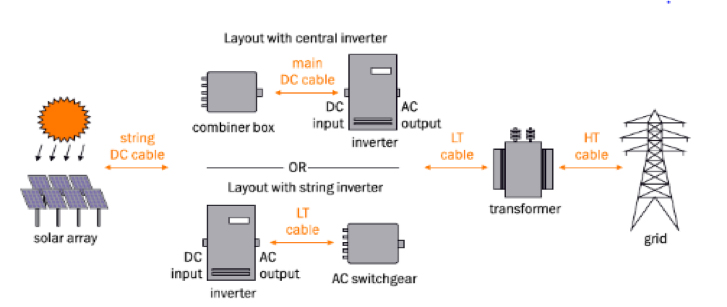A large variety of tools are available on the web to help source cable.
Photovoltaic wire, also known as PV wire, is a single-conductor wire used to connect the panels of a photovoltaic electric energy system. A solar cable is the interconnection cable used in photovoltaic power generation. Solar cables interconnect solar panels and other electrical components of a photovoltaic system. Solar cables are designed to be ultraviolet resistant and weather resistant.
It is very important to use the accurate solar cable size when connecting many components of a solar energy system.
Properly sizing the cables ensures that there is practically no overheating and very little loss of energy. Using an undersized cable not only poses a potential for causing a fire due to overheating but is also a code violation in most jurisdictions.
The actual size of the wire is can measure in AWG (American Wire Gauge) and is a standardized wire gauge measuring system. As a rule of thumb, the bigger the AWG number, smaller is the wire. A16 AWG wire is shorter than a 12 AWG wire, which is way smaller than a 4 AWG wire.

A large variety of tools are available on the web which helps in choosing a properly sized cable for your solar panel installation
Cables are subjected to thermal, mechanical, and external loads. Just like the rest of the system, cables need to last the stipulated 25 years or more. Being exposed to harsh environmental conditions like temperature fluctuations and direct ultraviolet rays can damage unprotected cables and in turn, the wires in them that carry the power generated.
Single-core cables with a maximum permissible DC voltage of 1.8 kV and a temperature range from –40°C to +90°C are the norm here.
A metal mesh encasing the cables improves shielding and over-voltage protection, and their insulation must not only be able to withstand thermal but also mechanical load.
For a functional PV wire system, You required to wire the panels together to produce an electrical circuit through which current will be flow, You also required to wire the panel to the inverter that will convert the dc power produced by panels to ac power that can be used in your house and also sent to the grid. That is typically called stringing and each series of panels which connected to each other is called as a string.
PARALLEL CONNECTIONS
Parallel connections are mostly utilized in smaller, basic systems and commonly with PWM Controllers, although they are inceptions. If we connect panels in parallel it will increase the amps and keep the voltage same. This is usually used in 12V systems with multiple panels as the wiring is 12V panels in parallel allows you to keep charging capabilities 12V.
SERIES CONNECTIONS
Series connections are mostly utilized in a smaller system with MPPT Controller. In a series connection, the voltage level will be increased and keep the amperage same. This is the main reason why the series connection is used with MPPT Controller and that MPPT Controller actually is capable to accept the higher voltage input, and still able to charge your 12V or more batteries as well as. Renogy MPPT Controllers can accept hundred-volt inputs. The advantage of the series is that it is easy to transfer long distances. Like you have 4 Renogy 100 Watt panels in series, run it 100 feet and it will only use a thin 14 gauge wire.
There is much important information regarding your solar panels and inverter that you need before you can determine how to string your solar array.
1. Information about Inverter:
First of all, you will need to know the following inverter specs which can be read on the manufacturer data sheet for the product.
2. Information about Solar Panel
With the above information about selected inverter, we’ll also need to know the following data on selected panels.
There are following rules which guide us on how to string our solar panels.
3. Advance selection to optimize the design.
Scott Ellyson, CEO of East West Manufacturing, brings decades of global manufacturing and supply chain leadership to the conversation. In this episode, he shares practical insights on scaling operations, navigating complexity, and building resilient manufacturing networks in an increasingly connected world.